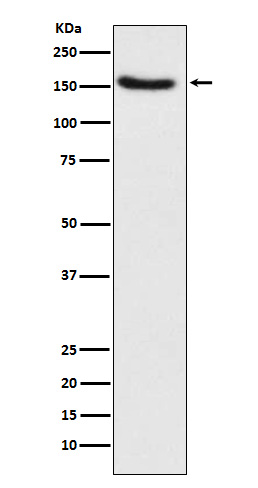
| WB | 咨询技术 | Human,Mouse,Rat |
| IF | 咨询技术 | Human,Mouse,Rat |
| IHC | IHC:1/100-1/200;IHF:1/50-1/200 | Human,Mouse,Rat |
| ICC | 1/50-1/200 | Human,Mouse,Rat |
| FCM | 1/20-1/100 | Human,Mouse,Rat |
| Elisa | 咨询技术 | Human,Mouse,Rat |
| Aliases | Hamartin; kiaa0243; LAM; TSC; Tsc1; Tuberous sclerosis 1;;Hamartin |
| WB Predicted band size | Calculated MW: 130 kDa ; Observed MW: 150 kDa |
| Host/Isotype | Rabbit IgG |
| Antibody Type | Primary antibody |
| Storage | Store at 4°C short term. Aliquot and store at -20°C long term. Avoid freeze/thaw cycles. |
| Species Reactivity | Human |
| Immunogen | A synthesized peptide derived from human Hamartin |
| Formulation | Purified antibody in PBS with 0.05% sodium azide,0.05% BSA and 50% glycerol. |
+ +
以下是3篇关于Hamartin(TSC1蛋白)抗体的参考文献示例(注:内容基于领域内典型研究方向,具体文献标题和作者可能有调整):
---
1. **文献名称**:*"TSC1 and TSC2 form a complex that integrates extracellular growth signals"*
**作者**:Kwiatkowski, D.J., et al.
**摘要**:研究利用Hamartin特异性抗体验证TSC1与TSC2蛋白的相互作用,发现两者形成的复合物通过调控mTOR信号通路抑制细胞增殖,为结节性硬化症的分子机制提供依据。
---
2. **文献名称**:*"Mutation analysis of the TSC1 gene in patients with tuberous sclerosis complex"*
**作者**:Dabora, S.L., et al.
**摘要**:通过Western blot和免疫组化实验,使用Hamartin抗体检测TSC1基因突变患者的蛋白表达水平,发现部分突变导致Hamartin稳定性下降,影响其肿瘤抑制功能。
---
3. **文献名称**:*"Subcellular localization of TSC1/TSC2 complex determines mTORC1 activity"*
**作者**:Ghosh, S., et al.
**摘要**:研究利用Hamartin抗体进行免疫荧光定位,揭示TSC1-TSC2复合物在细胞质中的分布变化与mTORC1信号激活的相关性,阐明其在细胞代谢中的动态调控。
---
如需具体文献来源,建议通过PubMed或Google Scholar检索关键词“Hamartin antibody TSC1”或联系相关领域学者获取实验方法学论文。
Hamartin, encoded by the *TSC1* gene, is a tumor suppressor protein central to the regulation of cell growth and metabolic homeostasis. It forms a heterodimeric complex with tuberin (product of *TSC2*), collectively known as the TSC complex, which acts as a critical inhibitor of the mechanistic target of rapamycin (mTOR) signaling pathway. By integrating upstream signals such as nutrient availability, growth factors, and cellular stress, the TSC complex modulates mTOR activity, thereby controlling protein synthesis, autophagy, and cell proliferation. Dysregulation of Hamartin due to *TSC1* mutations disrupts this regulatory mechanism, leading to constitutive mTOR activation, a hallmark of tuberous sclerosis complex (TSC), a genetic disorder characterized by benign tumors in multiple organs, neurological deficits, and epilepsy.
Hamartin-specific antibodies are essential tools in biomedical research, enabling the detection and quantification of Hamartin expression in tissues or cell lines. They are widely used in techniques like Western blotting, immunohistochemistry, and immunofluorescence to study protein localization, interaction partners, and post-translational modifications. These antibodies also aid in diagnosing TSC and evaluating therapeutic responses to mTOR inhibitors (e.g., rapamycin analogs). Validated antibodies with high specificity are crucial, as cross-reactivity with unrelated proteins can confound results. Researchers often employ knockout cell lines or siRNA-mediated *TSC1* depletion to confirm antibody specificity. Beyond TSC, Hamartin antibodies contribute to broader studies on mTOR-driven pathologies, including cancer, metabolic disorders, and neurodegenerative diseases, underscoring their versatility in both basic and translational research.
×